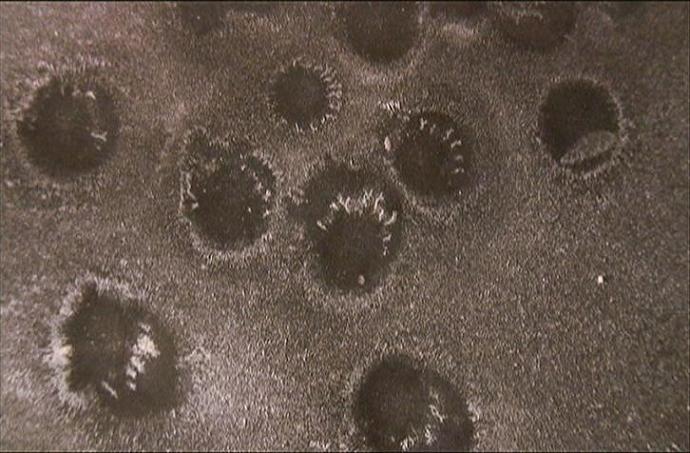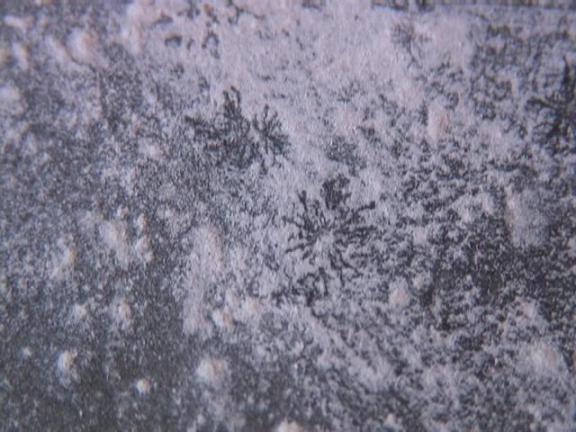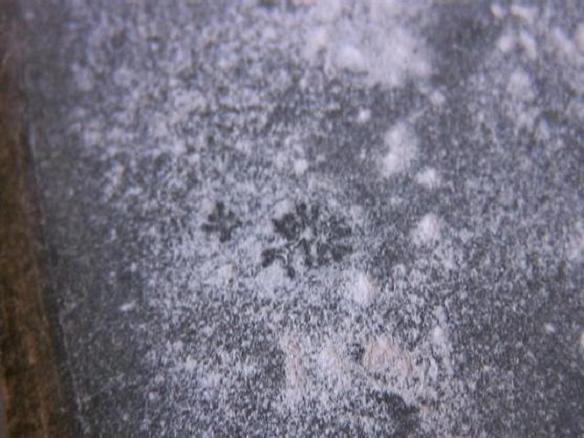Electric Discharges to Dust Covered Surface Show Similarity to Features of Planetary BodiesAuthor: z dahlen parker Contributors; tbolts.info Forum Participants Presentation assistant: Mr.Weiss , Karlsruhe, Germany Thanks go out to Jan Weiss for placing this poster at ICOPs08 |
| An enigmatic
feature on Mercury shares many features with the images
below. If their simaliraties are allowed as evidence of the mechanism responsible for formation then electric discharge should be considered in all its potential. |
 Another angle Relative size Center feature was from multiple discharges. Note the 5:00 radial that reaches from an adjacent feature (upper-left) toward the centeral one. |
The pattern of excavated material is uniform and does not overlap other spiders. This may be the result of limited- charge-scavanging from only the areas which have available charge along the balanced-tendrils of the coronal aspect of the electrical interaction. |
 From CRT experiment with electric discharge. These features have Lichtenberg characteristics. (lightening like)
|
Image at below: Surface of acrylic insulator used in terawatt pulsed-power generator reveals the consequence of dielectric breakdown between surface and sub-surface charged potentials. Lichtenberg characteristics are common. (Lightening-like)  Surface Discharge Image credit: Physics of the Plasma Universe, A.L. Peratt |
| Trench-like
depression are a common feature on most celestial bodies. They
are similar in many ways so, this require that the same
mechanism be applied to all. Since these from Mercury are radial features then many conventional geologic explanations cannot be applied. They would not occur in radial fashion. The presence of finely divided debris surrounding the crater, rather than large chunks of material supports an electric discharge mechanism more than a cause from impact. |
 . .
|  Note the feature at lower center. There are only three discharge features to highlight for this evaluation. They all have Lichtenberg characteristics. |
 Had a stronger discharge and deeper material been used A central crater would have been formed. Probably like the one seen below, if other experimental results be any indication for expectations. |
As the two covers of a book house the story
within, these two images are telling of the diverse capability of an electric discharge at making features that are seen around the solar system on solid bodies. In the smallest of detail these can be matched with features in full size. You may think I am deviating a bit from spider features until I tell you that the same discharge that made a feature on the left also made a feature on the right as two CRT screen were passed in close proximity. Three passes are represented. The similarities are further emphasized by the planetary images below from Mercury and Mars. |  Note the interior fingers in the features of these two images. |

Credit: NASA/Johns Hopkins University Applied Physics Laboratory/ Carnegie Institution of Washington | Considering that the images above reveal the effects at each side of an electric arc, we might wonder about the similarities with these images from Mercury and Mars. Electric discharges leave unmistakable patterns |  Mars Image Planetary Image credits. Nasa, JPL, MOC, HiRISE, MDIS, Special thanks to: tbolts.info participants StefanR, Solar, Arcus, Seasmith, Starbiter, MGmirkin, Redeye and maybe you. Acknowledgements: Wal Thornhill, www.holoscience.com Kronia group www.tbolts.info ALP |


